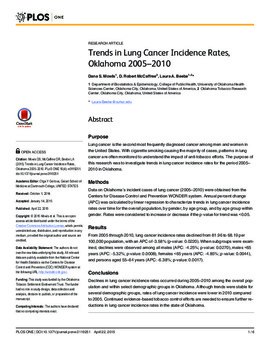| dc.contributor.author | Dana S. Mowls | |
| dc.contributor.author | D. Robert McCaffree | |
| dc.contributor.author | Laura A. Beebe | |
| dc.date.accessioned | 2017-03-05T22:54:50Z | |
| dc.date.available | 2017-03-05T22:54:50Z | |
| dc.date.issued | 2015-04-22 | |
| dc.identifier.citation | Mowls DS, McCaffree DR, Beebe LA (2015) Trends in Lung Cancer Incidence Rates, Oklahoma 2005–2010. PLoS ONE 10(4): e0119251. doi:10.1371/journal.pone.0119251 | en_US |
| dc.identifier.uri | https://hdl.handle.net/11244/49255 | |
| dc.description | | en_US |
| dc.description | | en_US |
| dc.description.abstract | Purpose Lung cancer is the second most frequently diagnosed cancer among men and women in the United States. With cigarette smoking causing the majority of cases, patterns in lung cancer are often monitored to understand the impact of anti-tobacco efforts. The purpose of this research was to investigate trends in lung cancer incidence rates for the period 2005–2010 in Oklahoma. Methods Data on Oklahoma’s incident cases of lung cancer (2005–2010) were obtained from the Centers for Disease Control and Prevention WONDER system. Annual percent change (APC) was calculated by linear regression to characterize trends in lung cancer incidence rates over time for the overall population, by gender, by age group, and by age group within gender. Rates were considered to increase or decrease if the p-value for trend was <0.05. Results From 2005 through 2010, lung cancer incidence rates declined from 81.96 to 68.19 per 100,000 population, with an APC of -3.58% (p-value: 0.0220). When subgroups were examined, declines were observed among all males (APC: -4.25%; p-value: 0.0270), males <65 years (APC: -5.32%; p-value: 0.0008), females <65 years (APC: -4.85%; p-value: 0.0044), and persons aged 55–64 years (APC: -6.38%; p-value: 0.0017). Conclusions Declines in lung cancer incidence rates occurred during 2005–2010 among the overall population and within select demographic groups in Oklahoma. Although trends were stable for several demographic groups, rates of lung cancer incidence were lower in 2010 compared to 2005. Continued evidence-based tobacco control efforts are needed to ensure further reductions in lung cancer incidence rates in the state of Oklahoma. | en_US |
| dc.language.iso | en_US | en_US |
| dc.publisher | PLos One | |
| dc.relation.ispartofseries | PLoS ONE 10(4): e0119251 | |
| dc.relation.uri | http://www.plosone.org/article/info%3Adoi%2F10.1371%2Fjournal.pone.0119251 | |
| dc.rights | Attribution 3.0 United States | |
| dc.rights.uri | https://creativecommons.org/licenses/by/3.0/us/ | |
| dc.subject | Lung and intrathoracic tumors,Oklahoma,Tobacco control,Smoking habits,Antigen-presenting cells,Demography,Age groups,Statistical methods | en_US |
| dc.title | Trends in Lung Cancer Incidence Rates, Oklahoma 2005–2010 | en_US |
| dc.type | Research Article | en_US |
| dc.description.peerreview | Yes | en_US |
| dc.description.peerreviewnotes | http://www.plosone.org/static/editorial#peer | en_US |
| dc.identifier.doi | 10.1371/journal.pone.0119251 | en_US |
| dc.rights.requestable | false | en_US |

